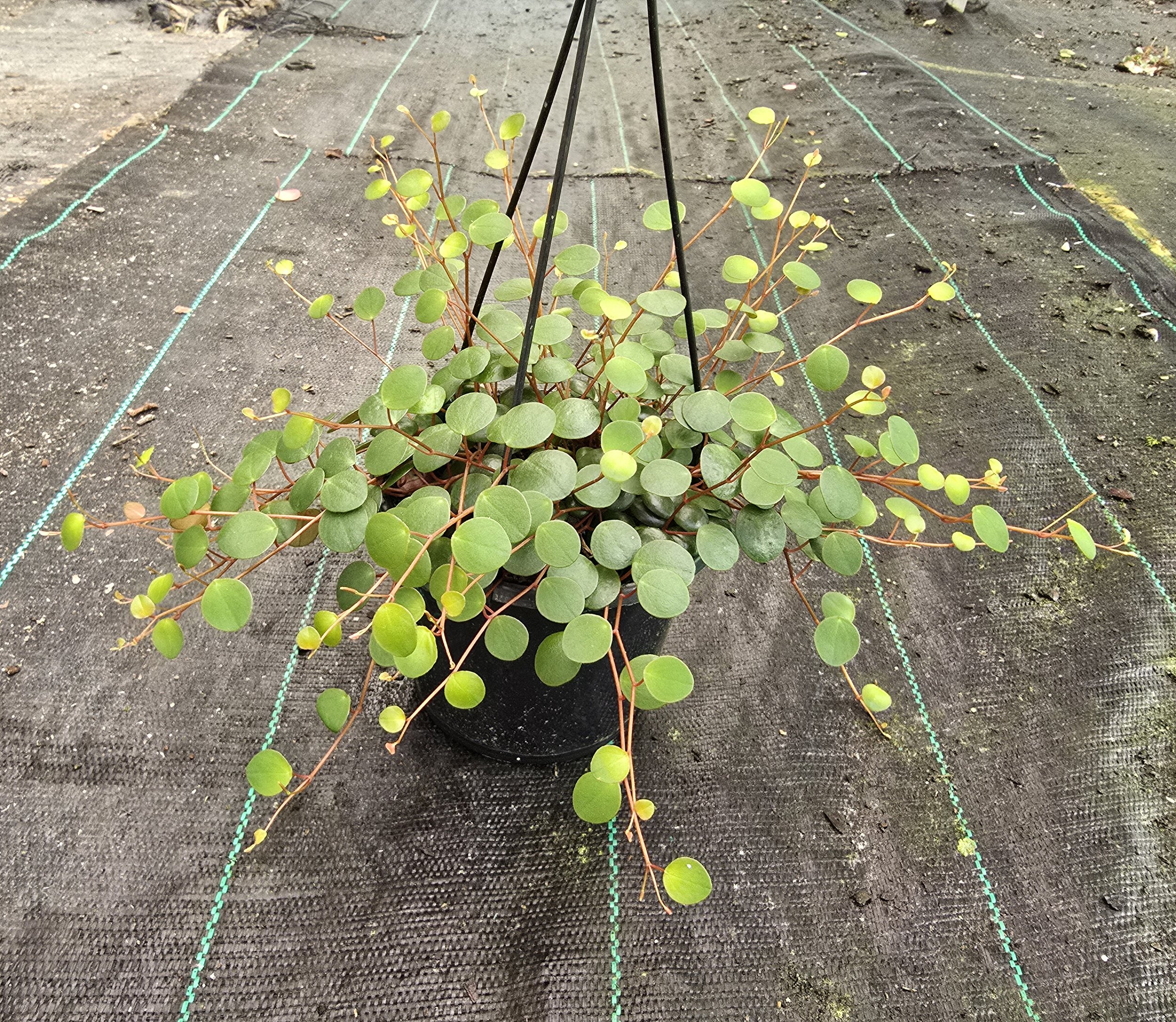 Image 1 of 1
Image 1 of 1


Peperomia pepperspot
🌿 Peperomia ‘Pepperspot’
Scientific Name:
Peperomia rotundifolia var. Pepperspot (Some sources list it as a cultivar of Peperomia prostrata or a variety within Peperomia rotundifolia)
Common Names:
Pepperspot Peperomia, Trailing Peperomia, String of Coins
Family:
Piperaceae (Pepper family)
Origin:
Native to South America, particularly rainforest regions of Brazil and surrounding countries.
📏 Physical Description
Growth Habit:
A small, trailing, evergreen perennial well-suited for hanging baskets, shelf edges, or terrariums.Leaves:
Tiny, round to oval, bead-like leaves, approximately 0.5–1 cm across, with a rich glossy green top and often a reddish or burgundy tinge on the undersides and stems.Stems:
Thin, reddish to maroon-colored trailing stems that can grow 30–60 cm (1–2 feet) long or more.Overall Look:
Soft, spilling, and jewel-like—giving a lush, trailing effect.
🌸 Flowers
Bloom Time:
Spring and summer, though flowers are tiny, pale, and spike-like, typical of Peperomias.
They appear on slender stalks, but the plant is mostly grown for its ornamental foliage.
🌱 Care and Cultivation
Light:
Prefers bright, indirect light.
Can tolerate lower light, but growth will be slower and stems may stretch.
Avoid direct afternoon sun which can scorch the leaves.Watering:
Water moderately, letting the top 2–3 cm of soil dry out before watering again.
Sensitive to overwatering and root rot.
Being semi-succulent, it stores moisture in its leaves and stems.Humidity:
Enjoys moderate to high humidity, but adapts well to average household conditions.
Perfect for bathrooms or kitchens.Soil:
Prefers a light, well-draining soil mix, such as a blend of cactus soil and peat moss or a good indoor potting mix with added perlite.Temperature:
Ideal range: 18–24°C (65–75°F).
Avoid exposure to temperatures below 10°C (50°F).Fertilizing:
Feed with a diluted liquid houseplant fertilizer every 4–6 weeks during spring and summer.Propagation:
Very easy from stem cuttings.
Cut a healthy trailing stem, allow it to callous for a few hours, then place it in moist soil or water until roots develop.
✅ Common Uses
Hanging planters
Trailing shelf displays
Terrariums
Ground cover in indoor dish gardens
Its compact, trailing habit makes it great for small spaces and urban gardening.
✅ Potential Issues
Overwatering: Leading cause of plant death. Let soil dry between waterings.
Legginess: Caused by low light—move to a brighter location.
Pests: Occasionally susceptible to fungus gnats, mealybugs, or spider mites if stressed.
✅ Quick Care Summary
RequirementDetailsLightBright, indirect (avoids harsh sun)WaterLet soil dry slightly between wateringsSoilLight, well-draining potting mixTemperature18–24°C (65–75°F)HumidityModerate to highPropagationVery easy from stem cuttings
🌿 Peperomia ‘Pepperspot’
Scientific Name:
Peperomia rotundifolia var. Pepperspot (Some sources list it as a cultivar of Peperomia prostrata or a variety within Peperomia rotundifolia)
Common Names:
Pepperspot Peperomia, Trailing Peperomia, String of Coins
Family:
Piperaceae (Pepper family)
Origin:
Native to South America, particularly rainforest regions of Brazil and surrounding countries.
📏 Physical Description
Growth Habit:
A small, trailing, evergreen perennial well-suited for hanging baskets, shelf edges, or terrariums.Leaves:
Tiny, round to oval, bead-like leaves, approximately 0.5–1 cm across, with a rich glossy green top and often a reddish or burgundy tinge on the undersides and stems.Stems:
Thin, reddish to maroon-colored trailing stems that can grow 30–60 cm (1–2 feet) long or more.Overall Look:
Soft, spilling, and jewel-like—giving a lush, trailing effect.
🌸 Flowers
Bloom Time:
Spring and summer, though flowers are tiny, pale, and spike-like, typical of Peperomias.
They appear on slender stalks, but the plant is mostly grown for its ornamental foliage.
🌱 Care and Cultivation
Light:
Prefers bright, indirect light.
Can tolerate lower light, but growth will be slower and stems may stretch.
Avoid direct afternoon sun which can scorch the leaves.Watering:
Water moderately, letting the top 2–3 cm of soil dry out before watering again.
Sensitive to overwatering and root rot.
Being semi-succulent, it stores moisture in its leaves and stems.Humidity:
Enjoys moderate to high humidity, but adapts well to average household conditions.
Perfect for bathrooms or kitchens.Soil:
Prefers a light, well-draining soil mix, such as a blend of cactus soil and peat moss or a good indoor potting mix with added perlite.Temperature:
Ideal range: 18–24°C (65–75°F).
Avoid exposure to temperatures below 10°C (50°F).Fertilizing:
Feed with a diluted liquid houseplant fertilizer every 4–6 weeks during spring and summer.Propagation:
Very easy from stem cuttings.
Cut a healthy trailing stem, allow it to callous for a few hours, then place it in moist soil or water until roots develop.
✅ Common Uses
Hanging planters
Trailing shelf displays
Terrariums
Ground cover in indoor dish gardens
Its compact, trailing habit makes it great for small spaces and urban gardening.
✅ Potential Issues
Overwatering: Leading cause of plant death. Let soil dry between waterings.
Legginess: Caused by low light—move to a brighter location.
Pests: Occasionally susceptible to fungus gnats, mealybugs, or spider mites if stressed.
✅ Quick Care Summary
RequirementDetailsLightBright, indirect (avoids harsh sun)WaterLet soil dry slightly between wateringsSoilLight, well-draining potting mixTemperature18–24°C (65–75°F)HumidityModerate to highPropagationVery easy from stem cuttings